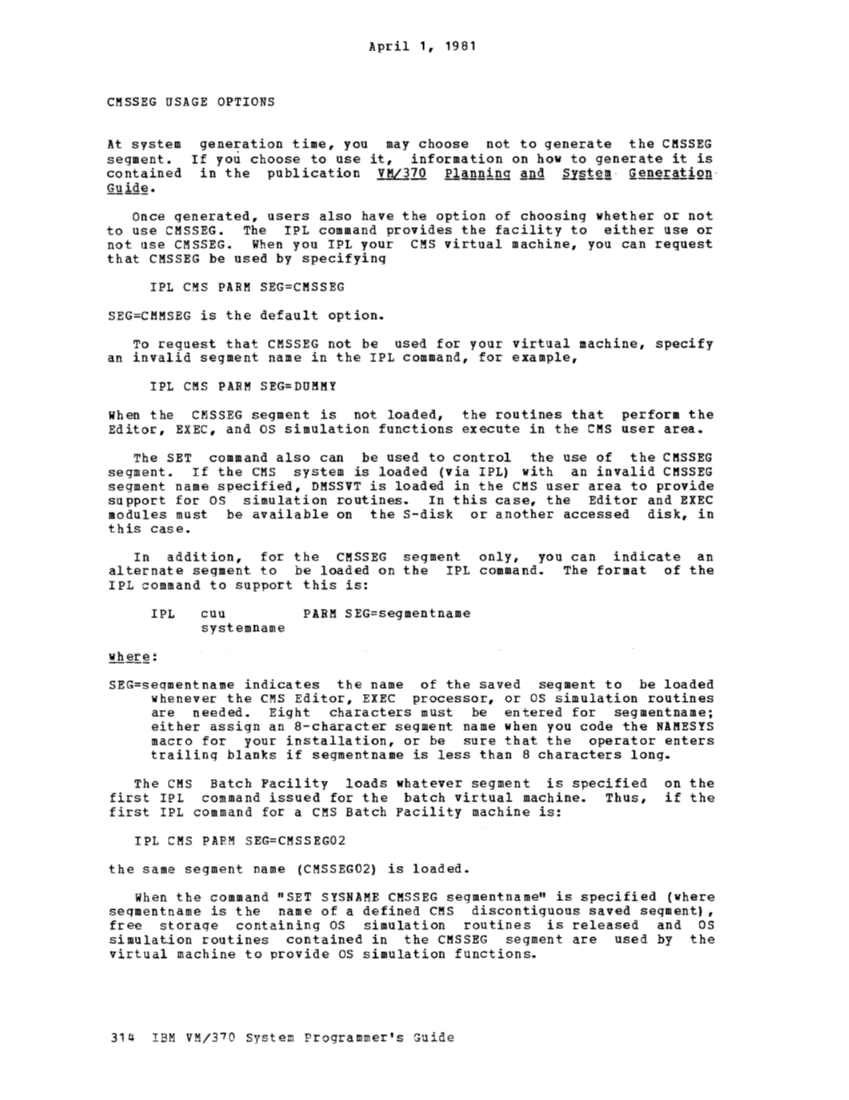April 1, 1981 CMSSEG USAGE OPTIONS At system
segment.
contained
GuCMSSEG If you choose to use it, information on how to generate it is
in the publicationVM/370 Plan!!!M: gnd Once generated, users also have the option of choosing whether or not
to useCMSSEG. The IPL command provides the facility to either use or
not useCMSSEG. When you IPL your CMS virtual machine, you can request
thatCMSSEG be used by specifying IPL CMS PARM SEG=CMSSEG SEG=CMMSEG is the default option.
To request thatCMSSEG not be used for your virtual machine, specify
an invalid segment name in the1PL command, for example, IPL CMS PARM SEG=DUMMY When the CMSSEG segment is not loaded, the routines that perform the
Editor, EXEC, andOS simulation functions execute in the CMS user area.
TheSET command also can be used to control the use of the CMSSEG segment. If the CMS system is loaded (via IPL) with an invalid CMSSEG segment name specified, DMSSVT is loaded in the CMS user area to provide
support forOS simulation routines. In this case, the Editor and EXEC modules must be available on the S-disk or another accessed disk, in
this case.
In addition, for theCMSSEG segment only, you can indicate an
alternate segment to be loaded on theIPL command. The format of the IPL command to support this is: 1PL cuu PARM SEG=segmentname
systemname
SEG=seqmentname indicates the name of the saved segment to be loaded
whenever theCMS Editor, EXEC processor, or OS simulation routines
are needed. Eight characters must be entered for segmentname;
either assign an 8-character segment name when you code theNAMESYS macro for your installation, or be sure that the operator enters
trailing blanks if segmentname is less than 8 characters long.
TheCMS Batch Facility loads whatever segment is specified
first1PL command issued for the batch virtual machine. Thus,
firstIPL command for a CMS Batch Facility machine is: IPL CMS PARM SEG=CMSSEG02 the same segment name (CMSSEG02) is loaded.
on the
if theWhen the command "SET SYSNAME CKSSEG segmentname" is specified (where
seqmentname is the name of a definedCMS discontiguous saved segment) ,
free storage containingOS simulation routines is released and OS CKSSEG segment are used by the
virtual machine to provideOS simUlation fUnctions.
314IBM VM/3 7 0 System Programmer's Guide
segment.
contained
Gu
in the publication
to use
not use
that
To request that
an invalid segment name in the
Editor, EXEC, and
The
support for
this case.
In addition, for the
alternate segment to be loaded on the
systemname
SEG=seqmentname indicates the name of the saved segment to be loaded
whenever the
are needed. Eight characters must be entered for segmentname;
either assign an 8-character segment name when you code the
trailing blanks if segmentname is less than 8 characters long.
The
first
first
on the
if the
seqmentname is the name of a defined
free storage containing
virtual machine to provide
314















































































































































































































































































































































































































































